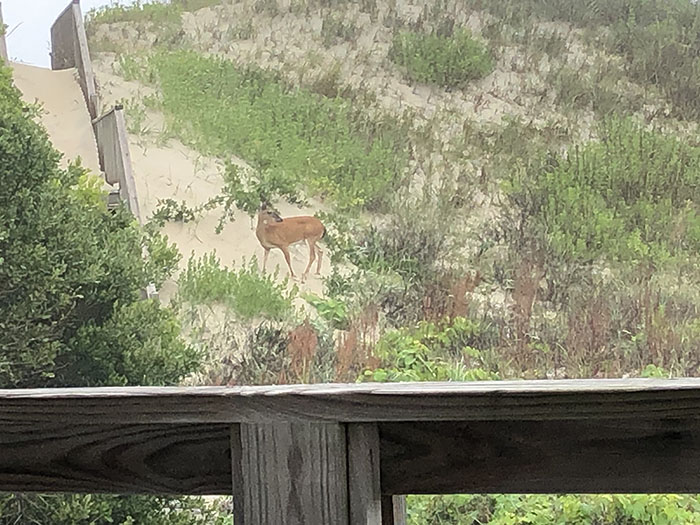
Photo by Marc Puckett
To celebrate our daughter’s high school graduation, we took a beach trip to Corolla on North Carolina’s Outer Banks last week (pronounced Co-rawl-luh…named after a section of a flower – gleaned from reading a book on the area’s history while there – and perhaps best known for its wild horse population). Sitting on the porch of our rented beach house, less than fifty yards from the roaring nor’easter driven tide, but protected by the dunes, I watched a field sparrow fly to the highest tip of the myrtle thicket and begin his familiar song. Gray catbirds were common visitors throughout our stay, as well as rufous sided towhees. Though the beach dune plant community was very different from that of an old field in piedmont Virginia, the structure was similar. Hidden in those thickets were also deer and rabbits and gray foxes…all seen during our visit. I have always been fascinated by the range of animals…their adaptability. It still surprises me to drive 200 miles from home to what I perceive as totally different habitats and find many of the same animals.
Thus, in terms of landowners who ask me what they should plant for quail, my response is quite often – nothing – learn to manage the cover that comes up where you are. Study what’s good, and what’s not and manage accordingly. The trick is maintaining the right habitat structure. “And how do I know that” you ask? “By observing the cover and the animals you see in it”, I say. Your reply, “but what if I do not have any quail to observe?”
It is time to learn about habitat associates. Often, landowners managing to attract bobwhite quail, see other species closely associated with their habitats show up first. Depending on what surrounds your land, it may take quail several years to find and occupy new suitable habitats, whereas field sparrows may show up as soon as conditions are favorable. I consider the field sparrow to be as closely associated with bobwhite quail in the east as any songbird. When their habits and habitats are examined, many similarities are clear. Their love of old fields, young clear cuts and abandoned agricultural lands, their diet, their habit of foraging and nesting on the ground, and a menu high in insects during summer are all in line with the bobwhites modus operandi. While there are differences, particularly in the number of acres of habitat needed, enough overlap exists to say that if you are hearing field sparrows on your land, there is a good chance it could be suitable for quail, too. This link takes you to Cornell’s Bird Site Field Sparrow Life History, All About Birds, Cornell Lab of Ornithology where you can read more about field sparrows, and listen to their songs.
Other song birds commonly associated with early-successional shrub-scrub habitats are rufous sided towhees (now known as Eastern towhees I believe) Eastern Towhee Overview, All About Birds, Cornell Lab of Ornithology , white eyed vireos White-eyed Vireo Overview, All About Birds, Cornell Lab of Ornithology , yellow-breasted chats Yellow-breasted Chat Overview, All About Birds, Cornell Lab of Ornithology , and prairie warblers (a name misnomer for sure) Prairie Warbler Overview, All About Birds, Cornell Lab of Ornithology – though it has prairie in its name, its habitats consist mainly of shrubby vegetation like young clear cuts, old fields, or open pine stands with a shrubby understory.
Have you been successful in your wildlife habitat management endeavors? Answering yes can mean adjusting your view of success. Not every situation will be conducive for bobwhite quail, but all is not burned toast. The species mentioned above and many more like them make habitat management success much more probable if you develop an appreciation for them. I am an avid upland bird hunter, who loves seeing a good bird dog work, and while it is true you won’t get many staunch points on field sparrows, during the eight months of the year when you can’t hunt gamebirds, these other fine creatures can sure make life interesting. And I am so thankful that I had their company on our beach trip, as the northeast wind blew a gale all week, making walks on the beach an adventure in human sandblasting, and surf fishing a fool’s errand (though this fool tried several times). Lastly, time is life and life is short, so make the most of it by expanding the list of things you appreciate and enjoy.




